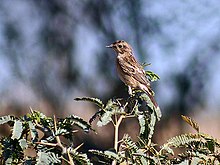Siberian stonechat
| Siberian stonechat | |
|---|---|

| |
| Male in breeding plumage, Mangaon, Maharashtra, India | |
| Scientific classification | |
| Kingdom: | |
| Phylum: | |
| Class: | |
| Subclass: | |
| Infraclass: | |
| Superorder: | |
| Order: | |
| Suborder: | |
| Infraorder: | |
| Superfamily: | |
| Family: | |
| Genus: | |
| Species: | S. maurus
|
| Binomial name | |
| Saxicola maurus (Pallas, 1773)
| |
| Synonyms | |
The Siberian stonechat or Asian stonechat (Saxicola maurus) is a recently validated species of the Old World flycatcher family (Muscicapidae). Like the other thrush-like flycatchers, it was often placed in the Turdidae in the past. It breeds in temperate Asia and easternmost Europe and winters in the Old World tropics.
Description, systematics and taxonomy


It resembles its closest living relative the European stonechat (S. rubicola), but is typically darker above and paler below, with a white rump and whiter underparts with less orange on the breast. The male in breeding plumage has black upperparts and head (lacking the brownish tones of the European stonechat), a conspicuous white collar, scapular patch and rump, and a restricted area of orange on the throat.[1]
The female has pale brown upperparts and head, white neck patches (not a full collar), and a pale, unstreaked pinkish-yellow rump. Males in winter plumage are intermediate between summer males and females, with a supercilium resembling the whinchat (S. rubetra); from this species and the female it can be distinguished by the full white collar.[1]
If seen at close distance, it can be recognized that its primary remiges are distinctly longer than in S. rubicola. In this, it closely resembles the whinchat, which like S. maurus is adapted to long-distance migrations.[1]
The male has a clicking call, like two pebbles knocked together. The song is high and twittering like the dunnock (Prunella modularis), an unrelated passeridan songbird belonging to the Passeroidea.[2]
Systematics and taxonomy
There are five or six subspecies, with S. m. maurus (described above) and the distinct but similar S. m. stejnegeri found across northern and central Asia. The southern S. m. variegatus (west of the Caspian Sea), S. m. armenicus (eastern Turkey to Iran), S. m. indicus (Himalaya) and the Turkestan stonechat S. m. przewalskii (southwest China) are distinguished by larger white areas on the plumage.[3]
In the past, S. maurus was usually included in S. torquatus as part of the "common stonechat", but that scientific name nowadays is restricted to the African stonechat. Analysis of mtDNA cytochrome b sequence and nDNA microsatellite fingerprinting data, though not unequivocal, together with the evidence from morphology, behaviour and biogeography confirms the suspicion that the present bird is a distinct species. The European stonechat is its western sister species in the Eurasian lineage of stonechats; their ancestors separated during the Late Pliocene or Early Pleistocene, roughly 1.5-2.5 million years ago at the onset of the Quaternary glaciation.[4]
Its scientific name means "dark rock-dweller". Saxicola derives from Latin saxum "rock" + incola "inhabitant"; maurus is Latinized from Greek maúros (μαύρος) "black" (cf. "moor"),[5] in reference to the upperpart colour as compared to S. rubicola.

Distribution and ecology
The breeding range covers most of temperate Asia, from about latitude 71°N in Siberia south to the Himalaya and southwest China, and west to eastern Turkey and the Caspian Sea area. It also breeds in the far northeast of Europe, mainly in Russia but occasionally as far west as Finland.[6]
The wintering range of the migratory bird is from southern Japan south to Thailand and India, and west to northeast Africa. On migration, small numbers reach as far west as western Europe, and exceptionally as far east as Alaska in North America.[1]
The Siberian stonechat is insectivorous. It breeds in open rough scrubland or rough grassland with scattered shrubs, from sea level to about 4,000 m ASL or more. The birds seem to avoid even cool temperate conditions and stay up north only during the hot continental summer. In the montane regions of the Himalaya foothills of Bhutan, migrants can on occasion be seen foraging in fields and pastures more than 2,000 m ASL, but most move further down and south to winter in tropical regions.[7]
Though it is not considered a distinct species by the IUCN yet, it is widespread and common and would not be considered a threatened species.[8]
Footnotes
- ^ a b c d Robertson (1977), Stoddart (1992), Urquhart & Bowley (2002)
- ^ Urquhart & Bowley (2002)
- ^ Bangs (1932), Urquhart & Bowley (2002)
- ^ Wittmann et al. (1995), Urquhart & Bowley (2002), Wink et al. (2002)
- ^ Jobling, James A. (2010). The Helm Dictionary of Scientific Bird Names. London, United Kingdom: Christopher Helm. pp. 243, 349. ISBN 978-1-4081-2501-4.
- ^ Robertson (1977), Urquhart & Bowley (2002)
- ^ Bangs (1932), Inskipp et al. (2000), Urquhart & Bowley (2002)
- ^ BLI (2009)
References
- Bangs, Outram (1932): Birds of western China obtained by the Kelley-Roosevelts expedition. Field Mus. Nat. Hist. Zool. Ser. 18(11): 343-379. Fulltext at the Internet Archive
- Template:IUCN2008
- Inskipp, Carol; Inskipp, Tim & Sherub (2000):"The ornithological importance of Thrumshingla National Park, Bhutan". Forktail 14: 147-162.
- Robertson, Iain (1977): Identification and European status of eastern Stonechats Brit. Birds 70: 237-245.
- Stoddart, Andy (1992): Identification of Siberian Stonechat Birding World 5(9): 348-356.
- Urquhart, Ewan & Bowley, Adam (2002): Stonechats. A Guide to the Genus Saxicola. Christopher Helm, London. ISBN 0-7136-6024-4
- Wink, M.; Sauer-Gürth, H. & Gwinner, E. (2002): Evolutionary relationships of stonechats and related species inferred from mitochondrial-DNA sequences and genomic fingerprinting. British Birds 95: 349-355. PDF fulltext
- Wittmann, U.; Heidrich, P.; Wink, M. & Gwinner, E. (1995): Speciation in the Stonechat (Saxicola torquata) inferred from nucleotide sequences of the cytochrome b-gene. Journal of Zoological Systematics and Evolutionary Research 33(2): 116-122. doi:10.1111/j.1439-0469.1995.tb00218.x HTML abstract
